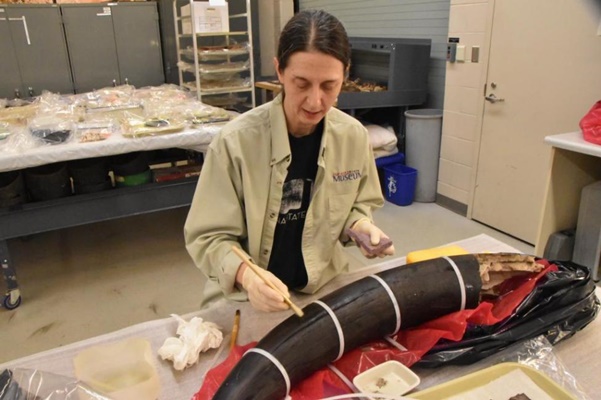
EVANSVILLE, Ind., May 4 (UPI) — Construction workers excavating a new sewer line in Indiana unearthed what scientists believe to be the remains of a 12,000-year-old mastodon that roamed the area at the end of the last Ice Age.
“When they called and told us they found bones, we thought they might be cattle bones,” said Tony Nehrt, one of the owners of the Seymour, Ind., farm on which the bones were found in April.
“We didn’t get the true picture until we saw the size of the bones. It is pretty amazing. It makes you wonder what the environment was like here that many years ago.”
The two leg bones and parts of a skull and tusk that excavators brought up were each several feet long. Scientists believe they came from a male mastodon that was about 42 years old.
“There could be additional bones down there,” Nehrt said. However, the city was on a tight timeline to finish the sewer project. “Since they were not human bones, there was no need to stop work.”
The family that owns the farm, which includes Nehrt’s wife and brother-in-law, has donated the remains to the nearby Indiana State Museum, which studies Ice Age paleontology in the state.
The museum has collected dozens of mastodon bones from all over Indiana — including two complete fossilized skeletons.
“The state is just full of them,” said Susannah Koerber, chief curator and research officer for the Indiana State Museum and Historic Sites. “If you dig deep enough down in any Indiana county, you’ll find mastodons. There could be one in your backyard.”
And it’s not just Indiana. Mastodons roamed across North America at the end of the last Ice Age. They were among what scientists call “megafauna” — massive herbivores that lived in the cool climates during that period.
At that time, the Midwest — and much of what is now the continental United States — had a much colder environment. Indiana, now known for its fields of corn and soy, was likely covered in a dense forest of spruce trees, similar to the spruce forests in Canada and the northernmost parts of the United States, Koerber said.
Mastodons fed on the woody brush in these forests.
The massive animals — close relatives of the woolly mammoth — became extinct about 10,000 years ago. Scientists are not sure why.
“There is a lot of speculation,” Koerber said.
One theory is that humans, who migrated into North America around the time mastodons disappeared, hunted them into extinction. The animals may also have failed to adapt to the warming climate. Or they could have fallen prey to disease.
“It could be a mix of all those things,” Koerber said. “It’s a big puzzle.”
But every new mastodon find brings scientists a little closer to solving that puzzle, she said. And the Seymour, Ind., mastodon — named Alfred — is a significant find. Its bones are well preserved compared to others found in the area. The soil in southern Indiana is not suited for such preservation.
“Finds like this help us understand better what life looked like during the Ice Age,” Koerber said. “Usually samples from southern Indiana are in pretty rough shape. But these remains are in good condition.”
The museum has sent samples of the bones for radiocarbon dating to verify their age. Museum scientists will spend the next year performing additional tests on the bones before they are put on display.
“It is amazing to be standing right next to something that lived 12,000 years ago,” Koerber said. “I try to imagine what that world was like. That was around the time the first people were coming into Indiana, and this was what they were seeing.”






